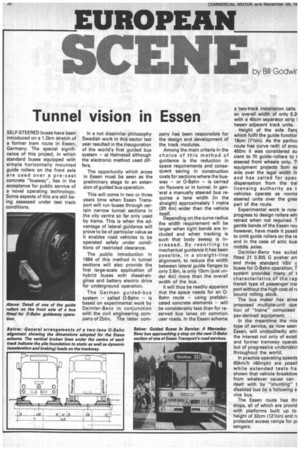by Bill Godwir
Page 28

If you've noticed an error in this article please click here to report it so we can fix it.
Tunnel vision in Essen
SELF-STEERED buses have been introduced on a 1.2km stretch of a former tram route in Essen, Germany. The special significance of this project, in which standard buses equipped with simple horizontally mounted guide rollers on the front axle are used over a pre-cast concrete "busway", lies in the acceptance for public service of a novel operating technology. Some aspects of this are still being assessed under test track. conditions. In a not dissimilar philosophy Swedish work in this sector last year resulted in the inauguration of the world's first guided bus system — at Halmstad although the electronic method used differs.
The opportunity which arose in Essen must be seen as the preliminary stage to an extension of guided bus operation.
This will come in two or three years time when Essen Transport will run buses through certain narrow tunnel sections in the city centre so far only used by trams. This is when the advantage of lateral guidance will prove to be of particular value as it enables road vehicles to be operated safely under conditions of restricted clearance.
The public introduction in 1984 of this method in tunnel sections will also provide the first large-scale application of hybrid buses with diesel-engines and battery electric drive for underground operation.
The German guided-bus system — called O-Bahn — is based on experimental work by Daimler-Benz in conjunction with the civil engineering company of Zblin. The latter corn
pany has been responsible for the design and development of the track modules.
Among the main criteria in the choice of this method of guidance is the reduction in space requirements and consequent saving in construction costs for sections where the busway — or O-Bahn — is carried on flyovers or in tunnel. In gen'eral a manually steered bus requires a lane width (in the straight) approximately 1 metre (3ft 4in) wider than the vehicle itself.
Depending on the curve radius the width requirement will be larger when tight bends are included and when tracking is such that body sweep is inc r e a se d . By resorting to mechanical guidance it has been possible, in a straight-line alignment, to reduce the width between lateral guide flanges to only 2.6m, ie only 10cm (just under 4in) more than the overall width of the bus.
It will thus be readily apparent that the space needs for an 0Bahn route — using prefabricated concrete elements — will be considerably less than for reserved bus lanes on common user roads. In the Essen scheme
a two-track installation calls an overall width of only 6.21 with a 40cm separator strip I tween adjacent track units.
Height of the side flanc which fulfil the guide functior 18cm (71/2in). As the particu route has curve radii of arou 450m it was considered su cient to fit guide-rollers to t steered front wheels only. TI equipment projects 5cm ez side over the legal width hr and has called for spec dispensation from the tral licensing authority as t vehicles operate as norma steered units over the grea part of the route.
Experimental work is now progress to design rollers whi retract when not required. T gentle bends of the Essen rou however, have made it possil to omit guide rollers on the re and in the case of artic bust middle axles.
Daimler-Benz has suitat fitted 21 0.305 G pusher art and three standard la31/ c buses for O-Bahn operation. T system provides many of t characteristics of the rap transit type of passenger trar port without the high cost of rE bound rolling stock.
The bus maker has alrea proposed multiple-unit ope tion of "trains" composed psv-derived equipment.
In the meantime the mix type of service, as now seen Essen, will undoubtedly attn the interest not only of existi and former tramway operatc but of progressive undertakin throughout the world.
In practice operating speeds 65km/h (40mph) are possil while extended tests ha shown that vehicle breakdow from whatever cause can dealt with by "shunting" t disabled bus by a following vice bus.
The Essen route has thr stops, all of which are provid with platforms built up to height of 32cm (121/2in) and rz protected access ramps for pz sengers.




































































































